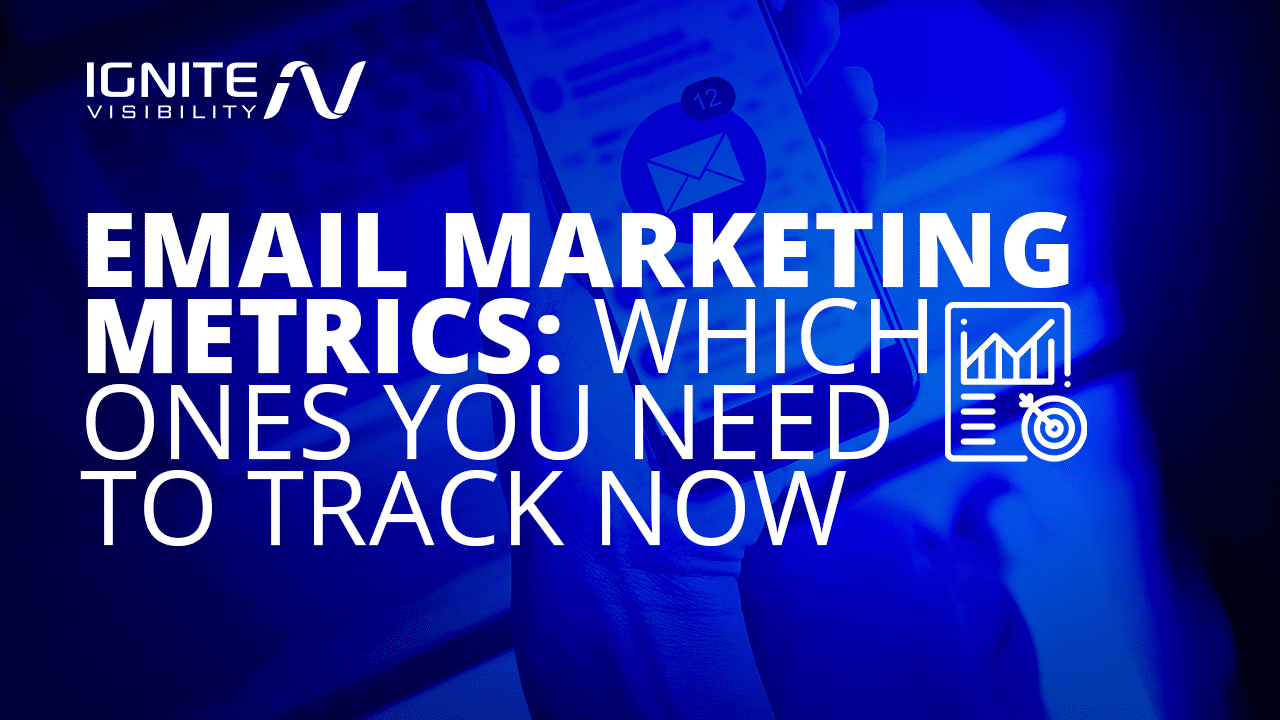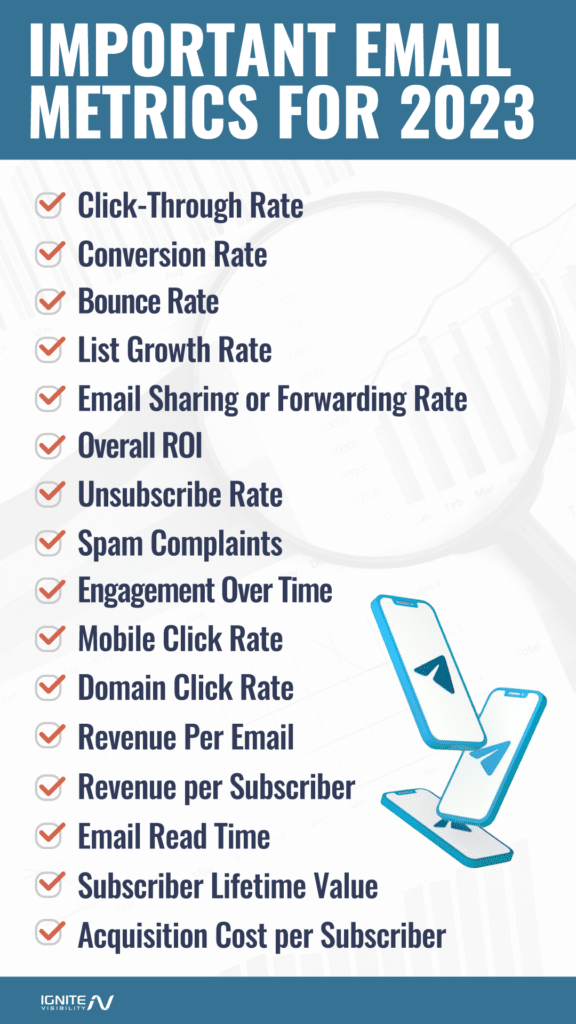
But when it comes down to it, how successful your campaigns are, depends on your business’s goals.
Are you using email marketing to grow your audience base or boost sales? Do you want it to direct traffic to your website or sell out your latest product?
Regardless of what success looks like to you, there are a few email marketing metrics that everyone should pay attention to.
Let’s talk about the most important email metrics for businesses today.
What Are Email Marketing Metrics?
Email marketing metrics are data points that help a business measure the performance of its email marketing campaigns.
Most email marketing platforms will provide this data. And remember, it’s important to keep an eye on these email metrics throughout your campaigns, not just sporadically.
How Have Email Marketing Metrics Changed Over Time?
Like anything else in digital marketing, email marketing is constantly evolving. Some of the metrics that marketers used to know and trust are suddenly obsolete.
Open rates used to be the most popular email marketing metric to track. It was the easiest to figure out and told you immediately if your audience’s eyes saw your content.
This all changed in the fall of 2021 when Apple announced a new feature – Mail Privacy Protection or MPP. This new feature allows Apple Mail users to opt-out of allowing the app to collect information such as if and when they open a specific email, what type of device they used to open them, or their geolocation. While this is a win for user privacy concerns, it was a huge hit to the world of email marketing, especially this particular metric.
This change only affects Apple Mail users, not other email giants like Google or Outlook. However, Apple Mail is one of the largest email providers in the world, and not having those numbers to rely on will give you really skewed data.
One of the most important email marketing metrics was tracking open rates. Now, it’s no longer considered a reliable metric.
Other Obsolete Email Marketing Metrics
Apple’s MPP update might have been the death of the open rate, but it also took down other email marketing metrics.
Before we pour into the details of shifting tides with metrics like open rates, let’s spotlight data provider selection. Choosing your data partner is akin to selecting just the right roast for your morning brew—critical for nuanced flavor and full-bodied results. Superior providers elevate mere data into distilled insights offering robust campaign direction.
Besides ruling out the once-popular open rate, you can also check the following email marketing metrics off of your list:
- Mobile Open Rate – the number of users who open your email on a mobile device
- Domain Open Rate – the number of users on a certain domain who open your email
- Geolocation Information – the information reported back to the marketer regarding the locations of their readers
While the MPP update changed a lot about email marketing, it’s nothing that skilled marketers can’t adjust to. It might take some strategic pivoting, but email marketing is still one of the most efficient and profitable forms of digital marketing.

What Are the Most Important Email Marketing Metrics?
Even though tracking the open rates of your emails might no longer be relevant, there are still a lot of other email marketing metrics you can track. Let’s talk about the most important ones.
Click-Through Rate
Your click-through rate is the number of subscribers who actually click on one of the links in your content. A lot of email marketers would consider the click-through rate the most important email marketing metric to track.
Although your email marketing platform probably already tracks this for you, if you want to manually find out your click-through rate, here is the formula: (Total Number of Clicks ÷ Number of Delivered Emails) x 100.
This gives you the percentage of your audience that clicked a link in your email. This is an especially helpful metric to track when performing A/B tests. Your click-through rate is a good indicator of which test performed better with your audience.
Conversion Rate
Conversion rate is the percentage of people who completed the call to action. If your goal was to get them to buy your product, your conversion rate is the email metric that tells you how many people bought your product.
To determine your conversation rate, use this formula: (Number of users who answered the call-to-action ÷ total emails delivered) x 100.
Bounce Rate
Your bounce rate is the number of emails that were sent by not delivered to the selected recipient. It includes two types of bounces: soft bounce and hard bounce. A soft bounce happens when the mailbox is full, the email provider’s server is down, or the email is too large. A hard bounce happens when the domain name isn’t real, the email address doesn’t exist, or the email server detected your domain as spam.
The formula to determine this email metric is: (Number of bounced emails ÷ total emails sent) x 100.
List Growth Rate
Your list growth rate is an important email marketing metric to track because it is the rate at which your list is growing. If your business isn’t growing, it’s dying, so it’s important to keep this number moving upward.
The formula to calculate your list growth rate is: [(Number of new subscribers – Number of unsubscribes – Number of bounces) ÷ Total number of email addresses on your list] x 100.
Email Sharing or Forwarding Rate
The next important email marketing metric to track is your email sharing or forwarding rate. This shows the number of people who shared your content to their social media accounts or forwarded your email to someone else.
It can be calculated by using this formula: (Number of share clicks/forwarded emails ÷ number of delivered emails) x 100.
Overall ROI
Your overall ROI (return on investment) shows you how valuable your investment was. Your accounting department is probably going to think this email marketing metric is the most important.
You can find your overall ROI by using this formula: ($ in sales made – $ invested in the campaign production) x 100.
Rather than focus on open rates, switch your focus to your click-through rate or conversion rate.
Unsubscribe Rate
Sometimes people are going to unsubscribe from your email list. There are a variety of reasons why this happens, and, as long as they don’t report your email as spam, it’s okay.
You can keep this number down by monitoring your unengaged subscribers and manually unsubscribing them. If they go some time without opening, reading, or clicking on your emails, go ahead and remove them from your list.
Spam Complaints
This email marketing metric is the number of people who mark your emails as spam. It is important to pay attention to who is marking you as spam and how often it happens because it greatly affects your deliverability.
If an email provider notices that people are marking you as spam, you have a bigger chance of getting caught by a spam filter, which means no one gets your emails.
Engagement Over Time
Engagement over time is an important email metric to track because it will give you insight into what time of day your audience likes to hear from you. You may notice that your audience tends to open late-night emails from your company more than they do early-morning ones. If that is the case, you’ll want to send your emails late at night. There’s a higher chance of your audience opening them.
Mobile Click Rate
The same goes for your mobile click rate. If you’re getting a high mobile click rate, make sure your landing page is optimized for mobile to increase your chances of closing a sale.
Domain Click Rate
Domain click rate is similar to domain open rate. If you notice that a particular domain is not getting as many click-through rates as it used to, check that domain’s spam policy to ensure there aren’t any issues.
Revenue Per Email
Revenue per email shows you the success of each individual email in a campaign. This can help you figure out if your audience likes a particular layout, content piece, or sending time better than another.
Revenue Per Subscriber
This email marketing metric helps you track your ROI more granularly. It helps you identify which demographics are really connecting with your content and which are losing interest. If they seem to be losing interest, it’s time to brainstorm ways to reignite them.
Email Read Time
Email read time shows you how many people read your content, skimmed it, and closed it immediately. This is a good way to judge the level of engagement you have with your audience.
Subscriber Lifetime Value
Subscriber lifetime value is an email metric that tells you how much money a particular subscriber has brought into your company over time.
You can determine this amount by using this formula: monthly revenue per subscriber x number of months they’ve been on your list.
Acquisition Cost Per Subscriber
Even if someone signs up for your list organically, you still paid for them somehow. This email marketing metric tells you the average cost that you’re paying per subscriber. You’ll want to know this number when looking at your marketing budget, especially when comparing it to things like paid ads.
To determine this email metric, use this formula: marketing cost ÷ number of new subscribers.

Wrapping it Up with Email Marketing Metrics
There you have it: the most important email marketing metrics that every digital marketer should be tracking. Use these metrics to determine if your campaigns are successful and how you can improve them if they aren’t.
And if you’re worried about the changes brought onto the world of email marketing from Apple’s MPP update, don’t be. This is the perfect time to adjust your email marketing strategy to incorporate more valuable and relevant information for your customers.
You can still do things to improve your email marketing ROI, such as monitoring and cleaning your email lists. Like anything with digital marketing, if you put a lot of effort and some quality strategy behind it, you’ll find a way to succeed.
If you need help, you can always reach out to an email marketing professional. Happy emailing!